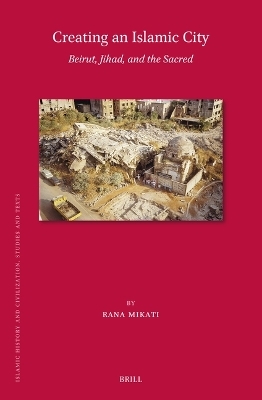
Creating an Islamic City
Brill (Verlag)
978-90-04-68254-2 (ISBN)
In Creating an Islamic City: Beirut, Jihad, and the Sacred, Rana Mikati examines for the first time the role and contribution of Beirut to the Umayyad and early Abbasid caliphates. This book traces the transformation of Beirut from a Byzantine metropolis to a place of ribāṭ, weaving previously unpublished archaeological material and narrative sources. By examining Beirut’s transformation into a frontier town, the rise of a scholarly community around the Syrian jurist al-Awzā‘ī (d. 157/773-774), and its integration in an Islamic sacred landscape, Creating an Islamic City shows how a provincial frontier town was integrated and participated in the early caliphate.
Rana Mikati, Ph.D. (2013), University of Chicago, is Associate Professor of Islamic History at the College of Charleston. She is the author of several articles on Early Islamic History.
Acknowledgements
List of Figures
Introduction
1 Beirut: History of Research
2 Beirut’s Islamic Past and the Politics of Identity
3 A Truncated Archaeological Record
4 Beirut: Not an “Islamic City”
5 A Fragmented Historical Record
6 The Story
1 Calamities: Beirut at the End of Antiquity
1 Late Antique Beirut: What Did the Muslim Armies Conquer?
2 “A House of Many Mansions:” The People of Beirut
3 Beirut and Mediterranean Bounty
4 Beirut and Trade Networks
5 A Series of Unfortunate Events
6 Conclusion
2 Beirut, the Coast, and Its Conquest
1 The Conquest of the Coast through Abbasid Eyes
2 Surrender Treaties
3 Beirut after the Conquest: A Tale of Continuity and Change
4 Soldiers: The Emergence of a Muslim Military Presence
5 Conclusion
3 Beirut, Sailors, and Ascetics
1 Sailors: The Creation of an Islamic Navy
2 Second Fitna (61–73/680–692) and the Coast
3 The Marwanids (65–132/685–750) and Naval Jihad
4 The Early Abbasids and the Navy
5 Ascetics: Piety and the Naval Frontier
6 Conclusion
4 Beirut and the Rise of Ribāṭ
1 The Ribāṭ of the Geographers and Archaeologists
2 The Case of the Wandering Salmān al-Fārisī
3 The Ribāṭ of the ʿUlamāʾ
4 Ribāṭ and the Coast
5 Conclusion
5 Beirut, the Imām, and Life on the Maritime Frontier
1 Before Beirut: al- Awzāʿī’s Rise to Prominence
2 Moving to Beirut: The Fall of the Umayyads and the Abbasid Transition
3 Al-Awzāʿī, His Family, and Community in Beirut
4 Al-Awzāʿī and the Army in Beirut
5 Al-Awzāʿī: Beirut and Beyond
6 Al-Awzāʿī’s Death
7 Conclusion
6 The Death of a Scholar: The Heirs of al-Awzāʿī in Beirut
1 The Second/Eighth Century: Socio-Political Transformation
2 The Second/Eighth Century: Intellectual Marginalizalition
3 Bequeathing a Scholarly Legacy
4 The Third/Ninth Century: A Missed Opportunity
5 Conclusion
7 A Few Good Men and a Woman: Beirut in the Muslim Imagination
1 The Islamic City and Sacred Hierarchies
2 Beirut, al-Nābulusī, and the Mapping of a Syrian Sacred Landscape
3 Al-Awzāʿī’s Sainthood
4 Manifestations of al-Awzāʿī’s Sainthood in Beirut
5 Al-Awzāʿī’s Lieux de Mémoire in Beirut and Its Environs
6 Beirut’s Other Saints
7 Sacred Landscapes: A Few Observations
8 Conclusion
Bibliography
Index
| Erscheinungsdatum | 06.03.2024 |
|---|---|
| Reihe/Serie | Islamic History and Civilization ; 210 |
| Zusatzinfo | 16 Illustrations, color; 13 Illustrations, black and white |
| Verlagsort | Leiden |
| Sprache | englisch |
| Maße | 155 x 235 mm |
| Gewicht | 714 g |
| Themenwelt | Geisteswissenschaften ► Geschichte ► Regional- / Ländergeschichte |
| Geisteswissenschaften ► Religion / Theologie ► Islam | |
| ISBN-10 | 90-04-68254-6 / 9004682546 |
| ISBN-13 | 978-90-04-68254-2 / 9789004682542 |
| Zustand | Neuware |
| Haben Sie eine Frage zum Produkt? |
aus dem Bereich


